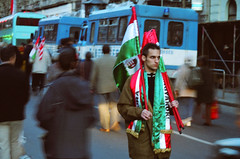The Hungarian TÁRKI Social Research Institute conducts an annual survey on xenophobia. As part of the survey, the sociologists ask respondents whether they would accept or refuse refugees from a list of specific ethnic backgrounds. Standard fare, so far.
Except as control group, they slip in a fictional group: the Pirezians.
Hungarian press agency MTI reports that once again, Hungarians blithely dismissed entry for these obviously no-good Pirezian refugees:

"Somewhere there is Piresia", the editors of Uncylopedia helpfully note
Sociologists divide Hungarians into three groups – 25-33 percent who would hermetically seal the country’s borders to all foreigners, 10 percent who would accept everyone with open arms, and the middle group of about 58 percent, who would pick and choose whom to accept, wrote [..] Nepszabadsag, citing a recent survey.
Sociologist Endre Sik pointed out that a key point in the survey [..] concerns the “Pirezians,” a non-existent ethnic group included in the survey as a reality-check. The two extremes on the scale for the pick-and-choose group are Arabs (rejected by 83 percent) and Russians (rejected by 76 percent) on the one side and ethnic Hungarians from neighbouring countries (rejected by 7 percent) on the other. The Pirezians were rejected by 66 percent of the mid-group, down slightly from last year’s 68 percent rejection figure, and up a bit from 59 percent in 2006.
The TARKI data reveal (Hungarian) that the middle, “pick-and-choose” group itself shrunk, while the xenophobic group that would hermetically seal the country’s borders to all foreigners grew in the past two years from 24% to 32%. So the group that would dismiss all foreigners, including those poor Pirezians, grew — and in addition, a larger part of the middle group looked askance at them as well. All in all, then, 70% of Hungarians want none of them Pirezians (Piresians?), against 65% two years ago.
Then again, other foreign peoples should be so lucky… It’s not just the Arabs and Russians that are even more undesired.
MTI doesn’t mention the Chinese, who are even more rejected than the Russians, if not quite as much as the Arabs. (Budapest has long been the centre of Chinese immigration in Eastern Europe; there have been as many as 20,000 Chinese in Hungary. Their number now is estimated at 10,000, who operate about 3,500 companies. “Chinese shop” means dirt-cheap jeans and t-shirts here. But that’s something for another post.)
Even, or should that be especially, the neighbouring Romanians are rebuffed – three-quarters of those in the middle group want to close the borders on them. We were here first, you know.
It’s easy to wonder whether the increased intolerance towards even a fictional minority is the result of the surge in nationalist politics that Hungary’s witnessed since the first big anti-government riots of September 2006. You may vaguely remember the ones from October 23rd that year, when one rioter commandeered a tank from 1956, which happened to be handily available as part of a public exposition to commemorate that year’s revolution, into the police lines. Nightly riots have become pretty much a standard feature of any national holiday or commemoration since. They erupted most recently when far right protestors pelted the Gay Pride parade with eggs and worse last July, and a couple of weeks ago when far right counterprotesters marched towards a demonstration of the anti-violence Democratic Charta movement. Both protests devolved into street battles.
But truthfully, the intolerance was always there. The TARKI survey has been conducted since 1992, and the systematically xenophobic group has oscillated between 15% and 43% of the population throughout, so this year’s number is no outlier, if on the higher end. The worst years were 1995 and 2000-2001.
Even ethnic Hungarians from abroad aren’t safe. Only a sliver of respondents in the TARKI survey may dismiss them, but when the conservative opposition party Fidesz launched a referendum in 2004 on offering them all Hungarian citizenship, the governing Socialists successfully rallied fears of a mass-influx of ethnically Hungarian Slovaks, Romanians and what not, and the burden they might pose on housing and benefits. The vote ended up evenly divided, but Prime Minister Gyurcsany’s appeal “not to vote yes” worked: with a turnout of just 37%, the result was invalid either way.
But back to those Pirezians. Who are they? This Romanian blog (Romanian) helpfully points to the Uncyclopedia (“the content-free encyclopedia”). Remember: TARKI asks this question every year, and a snarky story will unfailingly appear in one or the other newspaper. Some people pay attention. The Hungarian Uncylopedia has by now thought up a wealth of information (Hungarian) about Pirezia and its capital, Pirezia City. There’s a map, a “multiamorphous, polycoloured” flag, and a national anthem (“Pirezia, Pirezia, you are wonderful!”).
There’also s an overview of national holidays (presumably riot-less), some information about the Pirezian language (most closely related to Marezian, with which it constitutes the Pirezian-Marezian language family), and a list of famous Pirezians: William Shakespearez, Pamela Pirez (the pirez-up model), Augusto Pirochet, Picasso and Sandra Bullock (just because, I suppose).

Endre Sik
It’s no wonder that Endre Sik worried a little:
Although general xenophobia appears higher in the rural regions and south Hungary, Pirezian acceptance was lowest in generally more tolerant Budapest. Sik wondered if people questioned in Budapest had picked up on the fallacy, but a check of related parameters suggested that most had not.
Instead, then, he offers a laconic conclusion:
In lieu of a detailed study revealing exactly what characteristics made the Pirezians so disliked, Sik suggested that perhaps xenophobia was not based on any real knowledge, Nepszabadsag wrote.

